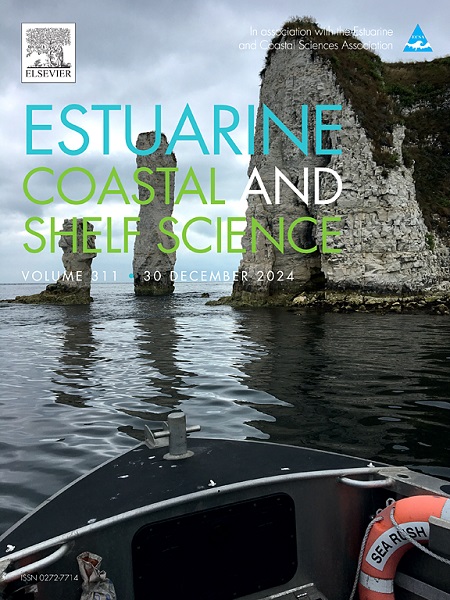响应气候变化的岛礁三维形态动力学模拟
IF 2.6
3区 地球科学
Q1 MARINE & FRESHWATER BIOLOGY
引用次数: 0
摘要
珊瑚礁岛被认为极易受到气候变化的影响,特别是由于它们在面临海平面上升和风暴加剧时海拔较低。海浪驱动的洪水和侵蚀预计会破坏这些岛屿,并迫使它们在几十年内无法居住。虽然已有一些研究试图解决波浪作用下礁岛水平一维(1DH)形态变化,但对三维(3D)岛屿演变的实验和数值研究在文献中很少。因此,本研究采用源自XBeach工具(XBeach- nh)的非流体静力分相模型,并结合其输沙模块。该模型以图瓦卢富纳富提环礁的Fatato岛为原型,复制了已发表的3D波盆实验。在模型验证后,研究了一个更广义的三维岛礁对各种气候变化指标的形态响应,包括SLR、风暴活动增加和珊瑚生长/退化。模拟结果表明,垂直波峰增生、吐槽旋转、泻湖岛屿退缩、岛屿陆上面积和体积减少是岛屿的核心响应。礁岛也被发现有能力垂直调整到SLR,增加风暴和珊瑚礁退化低于阈值。然而,随着这些指标的值进一步增加,它们的演变过程可能会加速,最终导致岛屿的毁灭。上述发现强调了将岛屿的形态动力学响应纳入沿海洪水模型的迫切必要性,从而更好地解决岛屿未来的持续性和稳定性问题。本文章由计算机程序翻译,如有差异,请以英文原文为准。
Three-dimensional morphodynamic modeling of reef islands in response to climate change
Coral reef islands have been viewed significantly vulnerable to the effects of climate change, especially due to their low elevations when facing sea-level rise (SLR) and intensifying storms. Wave-driven flooding and erosion are anticipated to undermining these islands and forcing them to be uninhabitable in a few decades. Although, several existing investigations have tried to tackle the horizontally one-dimensional (1DH) morphological change of reef islands subjected to waves, experimental and numerical investigations on the three-dimensional (3D) island evolution are rare in the literature. Therefore, this study employs a non-hydrostatic phase-resolving model originated from the XBeach tool (XBeach-NH), combined with its sediment transport module. The model was applied to reproduce the published 3D wave basin experiments which used the Fatato Island located at Funafuti Atoll, Tuvalu as the prototype. After model validation, the morphological responses of a more generalized 3D reef island to various climate change indicators, including SLR, increased storm activity and coral growth/degradation were investigated. Simulation results showed that vertical crest accretion, spit rotation, lagoonward island recession, island subaerial area and volume reduction were identified as the island's core responses. Reef islands were also found to have the capacity to adjust vertically to SLR, increased storminess and reef degradation below a threshold. However, their evolution processes can be accelerated as the values of these indicators further increased, eventually resulting in the destruction of the island. The above findings emphasize the pressing necessity to have the island's morphodynamic response integrated into the coastal flood models, thus the island's future persistence and stability could be better resolved.
求助全文
通过发布文献求助,成功后即可免费获取论文全文。
去求助
来源期刊
CiteScore
5.60
自引率
7.10%
发文量
374
审稿时长
9 months
期刊介绍:
Estuarine, Coastal and Shelf Science is an international multidisciplinary journal devoted to the analysis of saline water phenomena ranging from the outer edge of the continental shelf to the upper limits of the tidal zone. The journal provides a unique forum, unifying the multidisciplinary approaches to the study of the oceanography of estuaries, coastal zones, and continental shelf seas. It features original research papers, review papers and short communications treating such disciplines as zoology, botany, geology, sedimentology, physical oceanography.

 求助内容:
求助内容: 应助结果提醒方式:
应助结果提醒方式:


